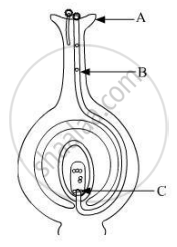Advertisements
Advertisements
प्रश्न
Accessory whorls : Calyx and corolla : : essential whorls : ______________
उत्तर
Accessory whorls : Calyx and corolla : : essential whorls : Androecium and gynoecium
APPEARS IN
संबंधित प्रश्न
Name the parts A, B and C shown in the diagram and write their functions.

In the following diagram showing the structure of embryo of a dicot seed, what are the parts marked I, II and III sequentially?

Answer the following question.
State significance of pollination.
A student identified the various parts of an embryo of a gram seed and listed them as given below :
(I) Testa
(II) Plumule
(III) Radicle
(IV) Cotyledon
(V) Tegmen
Out of these the actual parts of the embryo are :
(A) I, II, III
(B) II, III, IV
(C) III, IV, V
(D) II, IV, V
You are asked by your teacher to study the different parts of an embryo of a gram seed. Given below are the steps to be followed for the experiment:
I. Soak the gram seeds in plain water and keep them overnight.
II. Cut open a soaked seed and observe its different parts.
III. Take some dry gram seeds in a petri dish.
IV. Drain the excess water.
V. Cover the soaked seeds with a wet cotton cloth and leave them for a day.
The correct sequence of these steps is :
(A) III, I, V, IV, II
(B) III, I, II, IV, V
(C) III, IV, V, I, II
(D) III, I, IV, V, II
How does the process of fertilisation take place in flowers?
Name the part made up of the stigma, style and ovary.
Fill in the following blank with suitable word :
The ovary of a flower becomes ....... after fertilisation.
Fill in the following blank with suitable word :
The male organ of reproduction in the flower is the.......... .
Fill in the following blank with suitable word :
The.......... at the base of the carpel contains egg cells.
Name the part of a seed which grows into root.
In tobacco plant, the male gametes have 24 chromosomes.
What is the number of chromosomes in the female gamete?
What is meant by 'unisexual flowers' and 'bisexual flowers'? Give two examples of each.
What changes take place in the flower after fertilisation which lead to the formation of seeds and fruit?
(a) Draw a neat diagram of a flower showing its various parts. In this diagram mark stem, receptacle, sepals, petals, stamen and carpel.
(b) What name is given to (i) all the petals of a flower, and (ii) all the sepals of a flower?
(c) What are (i) stamen, and (ii) carpel, in a flower?
(d) What is the other name of carpel of a flower?
(e) What is the name of yellow powdery substance present in the anther of a flower?
One of the following occurs in the reproductive system of flowering plants as well as that of humans. This is :
(a) vas deferens
(b) anther
(c) ovary
(d) style
The flask-shaped organ A at the centre of a flower is surrounded by a number of little stalks B having swollen tops which lie just inside the ring of petals.
(a) Name A. What are the various parts of A?
(b) Which part of A contains gametes?
(c) Name B. What is the swollen top of B known as?
(d) What does the swollen top of b contain?
(e) Out of A and B, which one is (i) male part, and (ii) female part of the flower?
Fill in the blank by selecting suitable word:
A flower that bears both the male and the female parts is known as __________ flower.
Multiple choice question. Tick (✓) the correct choice:
Unisexual flowers are found in
- mulberry
- mustard
- pea
- sunflower
Mention the function of Stigma.
Describe an activity to demonstrate phototropism.
List any two differences between pollination and fertilisation.
Identify the odd. Stigma, Style, Pollen, Ovary.
What is pollination? Mention its types.
Differentiate between self-pollination and cross-pollination.
Distinguish between self-pollination and cross-pollination.
Write the events involved in the sexual reproduction of a flowering plant.
Discuss the first event and write the types.
In which of the following manner the arrangement of megaspores in a tetrad is observed in angiosperms?
How many middle layers are generally present in the wall of the anther lobes?
Which type of development is observed in male gametophytes of plants?
Conidia are formed endogenously while zoospores are formed endogenously.
Complete the table
| Carly x | ______ | ______ |
| ______ | petal | attract insects |
| Androecium | ______ | Male reproductive part |
| ______ | ______ | Female reproductive part. |
The ovaries of different flowers may contain
Double fertilization is exhibited by ______
Double fertilization is essential for formation of ______.
Double fertilization means ______.
In a plant flower the female whorl is ______.
Name the reproductive parts of an angiosperm. Where are these parts located? Explain the structure of its male reproductive part.
Type of sexual reproduction is ______.
